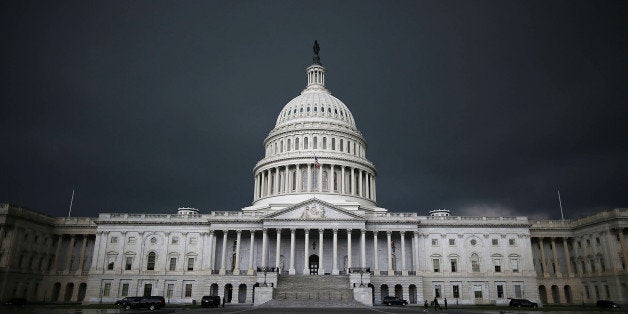
Welcome back once again to our ongoing pigeonholing exercise for this year's midterm Senate races. The big question, of course, is whether Republicans will pick up the six seats they need to wrest control of the chamber from the dastardly (according to them) Harry Reid and his Democratic minions. The answer to this pressing question is still not clear, and it actually may not be definitively answered until long after election night (for various interesting and wonky reasons).
Still, that doesn't stop the punditocracy ("wonkocracy," perhaps?) from making our predictions, so let's just dive in and make some rash and reckless prognostications, shall we? As always, in making these determinations I use the criteria of: news I've read about each race, all polling data available, and a good dose of common sense. That last one could also be read as "what my gut is telling me about each race," I fully admit.
The public is increasingly paying attention to each individual race, and in many states public debates have been held in the past week or so. Some races have firmed up as a result, and some are more chaotic than ever.
The current Senate stands at 45 Republicans and effectively 55 Democrats (counting in the two Independents who caucus with them). Because a tie vote is broken by Democratic Vice President Joe Biden, the Republicans need 51 seats to gain control of the chamber -- a net pickup of six seats. Throughout my categories, I will provide a running net total to see how close Republicans will come to achieving this goal, although the number of races which are totally up in the air precludes actually predicting whether it'll happen or not.
For those interested, my remarks below refer to my previous Senate overview column, from a few weeks ago. I use only five categories: Safe Democratic, Leaning Democratic, Too Close To Call, Leaning Republican, and Safe Republican. Any questions? Leave them in the comments, along with any disagreements you might have about which race belongs where.
Safe Republican
The list of Safe Republican states hasn't changed much: Alabama, Idaho, Maine, Mississippi, Montana, Nebraska, Oklahoma, South Carolina, Tennessee, Texas, West Virginia, and Wyoming. The only change here is that South Dakota moved down to Leaning Republican. More on that in a moment.
This starts Republicans with a net pickup of two seats (Montana and West Virginia) held by Democrats.
Safe Democratic
I'm going to go out on a limb and move New Hampshire into this category, because carpetbagger Scott Brown doesn't seem to be gaining any ground. The full list of Safe Democratic seats: Delaware, Hawai'i, Illinois, Oregon, Massachusetts, Michigan, Minnesota, New Hampshire, New Jersey, New Mexico, Rhode Island, and Virginia.
Some might argue my gut is being too optimistic about Michigan (as well as the inclusion of New Hampshire), but the news this week was that Republicans have very quietly cancelled all their last-minute ad buys because they think Michigan is now a lost cause for them. And who am I to argue?
However, none of these seats is currently in Republican hands, so this list represents no net gain or loss for Democrats in the Senate.
Leaning Republican
There was a lot of movement both in and out of this category this time around. Kentucky dropped down to Too Close To Call, while South Dakota was added, moving down from Safe Republican.
The race in Georgia remains very tight, and might even merit moving down to Too Close To Call next time around. The Republican was just caught in a cringe-worthy gaffe (where he extolled his personal experience outsourcing jobs to foreign countries), and then he essentially doubled down on his pro-outsourcing stance. This is not exactly a popular idea anywhere in America, so we'll see whether it improves Michelle Nunn's poll numbers in the next week or so.
Louisiana remains very close in the polling, but the Republican challenger to Mary Landrieu seems to be holding an edge. At this point, it has to be counted as Leaning Republican.
South Dakota is an interesting race because it has become a true three-way contest. Previously, the Republican was holding a big lead over the Democrat and the Independent was far behind, but recent polling shows the Independent moving up quickly, and one poll put his support higher than the Democrat's. However, both are still trailing the Republican, meaning at best the state has to be considered Leaning Republican. But anything can happen in the late days of a three-sided race, so it can't really be considered Safe Republican at this point.
If Republicans took all their leaning states, it would add two more takeovers (Louisiana and South Dakota) to their total, but it wouldn't put them over the top. They'd still be two states short of a Senate majority.
Leaning Democratic
The Leaning Democratic category shifted around a bit as well. New Hampshire moved up to Safe Democratic, Alaska moved down to Too Close To Call, and the special case of Kansas was added to this category (since it doesn't really belong anywhere else), up from Too Close To Call.
By the numbers, Colorado should probably be in Too Close To Call, but I'm more optimistic about Mark Udall's chances than perhaps I should be. It's been a tight race all year in the polling, but Udall seems to have retained an edge. In Colorado, as in many states, it's all going to come down to turnout. For now, I'm keeping it as Leaning Democratic, although admittedly a lot of that is just gut feeling.
Kansas doesn't really belong anywhere on this list, because there is no "Safe Independent" category. Since the dramatic exit of the Democratic candidate from this race, Greg Orman is beating Pat Roberts soundly in the polls. This is a breathtaking reversal of fortunes for Roberts, and has not changed much in the past few weeks. Of course, Orman refuses to say which party he'll caucus with if he wins, but at the very least this race is "leaning non-Republican" at the moment. A few more good polls, and it might even move up to "safe non-Republican" -- but that could all change after the election, if Orman does decide to caucus with Republicans after all.
North Carolina remains in this category, as Kay Hagen has held a small edge over her Republican challenger. If she manages to hold this lead, the Democrats will have won a very hard-fought race here. North Carolina is one of the states which have held candidate debates recently, so if any movement is going to happen (good or bad), look for it in the next week or so.
If Democrats win Colorado and North Carolina, if Greg Orman wins Kansas, and if (the biggest "if" in the list) Orman does caucus with the Democrats, they will have picked up one seat from Republicans. This brings our rolling total to a net of three Republican gains.
Too Close To Call
As always, this is the category with the most movement. Kansas moved upwards (this time around) to "leaning non-Republican," while Kentucky moved down from Leaning Republican and Alaska moved down from Leaning Democratic.
Up in Alaska, my gut still tells me Mark Begich is going to eke out a victory. Democrats have been spending a lot of "get out the vote" money here, and polling is notoriously unreliable in the state. However, the Republican has gotten a few good polls of late, so I have to bow to the numbers and classify the race as Too Close To Call, at least for the moment.
Arkansas is still incredibly close, as polls have been mixed (in some, the Republican has a tiny lead, in others Mark Pryor has a tiny lead). One interesting announcement from the campaign trail is that both Clintons, Bill and Hillary, will be stumping for Pryor in the coming days. The Clintons are still fondly remembered in Arkansas, so this may boost Pryor's numbers in the closing weeks. But it still remains one of the closest races in the country.
The other contender for closest race of 2014 is still Iowa, where Bruce Braley has been struggling but is still neck-and-neck with Joni Ernst. A scandal was recently announced (Ernst's husband getting government contracts while she was in a lower office), but it remains to be seen whether it'll affect the polling or not.
And, lastly, we have the race in Kentucky. Mitch McConnell has been up in the polls, and most everyone has called this race as either Leaning Republican or even Safe Republican, but Alison Lundergan Grimes just posted a lead over McConnell in the latest poll. This may be an outlier -- one poll showing a boost that doesn't actually exist -- but until this is made clear, the state has to be seen as Too Close To Call for now.
Assuming the lean and safe lists pan out, Republicans will have to win three out of these four races to capture control of the Senate from Harry Reid. If Democrats can manage to win any two of them (assuming Greg Orman from Kansas joins them), it would put control of the Senate out of reach for Republicans.
Chris Weigant blogs at:
Follow Chris on Twitter: @ChrisWeigant
Become a fan of Chris on The Huffington Post
